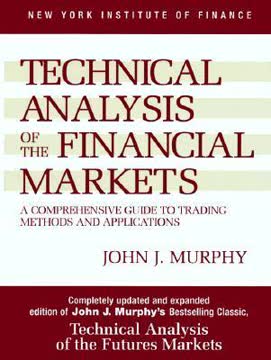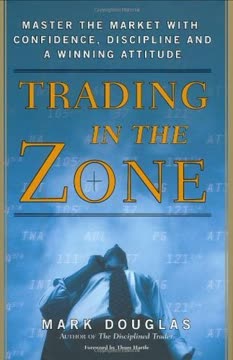Key Takeaways
1. Wyckoff Methodology: Understanding Market Structure and Cycles
"Financial markets are a living thing, they are constantly changing due to their continuous interaction between buyers and sellers."
Market cycles and structures. The Wyckoff Methodology provides a framework for understanding market behavior through the analysis of price and volume. It recognizes four main phases in market cycles: accumulation, uptrend, distribution, and downtrend. These phases are driven by the actions of large, informed traders (strong hands) and less informed traders (weak hands).
Key components:
- Price movement in waves of different sizes
- Trends: bullish, bearish, and lateral
- Trading ranges: accumulation and distribution
- Change of character (ChoCh) between phases
Understanding these structures allows traders to identify potential turning points and align their trades with the dominant market forces.
2. The Three Fundamental Laws: Supply and Demand, Cause and Effect, Effort and Result
"The law of cause and effect tells us that for there to be an effect, there must first be a cause that originates it; and that the effect will be in direct proportion to the cause."
Foundations of market analysis. The Wyckoff Methodology is built on three fundamental laws that govern market behavior:
- Law of Supply and Demand: Price movements are a result of imbalances between buying and selling pressure.
- Law of Cause and Effect: Price movements are proportional to the preparation (cause) that precedes them.
- Law of Effort and Result: Volume (effort) should confirm price action (result).
These laws provide a logical framework for interpreting market action and predicting future movements. By understanding the interplay between these laws, traders can make more informed decisions about market direction and potential turning points.
3. Accumulation and Distribution: Recognizing Market Campaigns
"During the accumulation process, large traders create an environment of extreme weakness."
Professional trader tactics. Accumulation and distribution are processes where large traders systematically build or liquidate positions. These campaigns often occur in trading ranges and set the stage for subsequent trend moves.
Key characteristics:
- Accumulation: Absorption of supply, creating a base for future upward movement
- Distribution: Absorption of demand, preparing for future downward movement
- Manipulation tactics: Creating false impressions of weakness or strength
- Tests: Probing for supply or demand levels
Recognizing these processes allows traders to position themselves alongside professional traders and anticipate major market moves.
4. The Five Phases of Market Structures: From Stopping Trends to New Movements
"Phase analysis helps us to structure the processes of accumulation and distribution, providing us with the general context of the market."
Structural framework. The Wyckoff Methodology breaks down market structures into five distinct phases:
- Phase A: Stopping the previous trend
- Phase B: Building the cause
- Phase C: Test
- Phase D: Trend within range
- Phase E: Trend out of range
Each phase has specific characteristics and events that help traders identify where the market is in its cycle. This framework provides context for trading decisions and helps anticipate future market movements.
5. Key Events in Market Structures: Identifying Critical Price Actions
"Shaking is the key event all Wyckoff traders are waiting for."
Crucial market actions. The Wyckoff Methodology identifies several key events within market structures that signal important shifts in supply and demand:
- Preliminary Support/Supply
- Climax (Selling/Buying)
- Automatic Rally/Reaction
- Secondary Test
- Spring/Upthrust
- Sign of Strength/Weakness
- Last Point of Support/Supply
Understanding these events helps traders identify potential turning points and high-probability trading opportunities. Each event provides insight into the balance of power between buyers and sellers and the likely future direction of the market.
6. Trading Strategies: Capitalizing on Market Structure Analysis
"Our trading and investment decisions will be based on the three elements that I believe are most important to consider in the discretionary reading of charts, in order: the context, the structures and the trading areas."
Strategic approach. Wyckoff traders focus on three primary trading areas:
- Phase C: Potential shakeouts or tests
- Phase D: Trend movements within the range and breakout tests
- Phase E: Trend continuation and reaccumulation/redistribution
Trading strategies are built around:
- Identifying the current market structure and phase
- Recognizing key events and price action signals
- Aligning trades with the dominant trend and larger timeframe context
- Using volume analysis to confirm price movements
By following these principles, traders can identify high-probability setups with favorable risk-reward ratios.
7. Risk Management and Position Sizing: Protecting Capital and Maximizing Profits
"A very useful way to carry out proper risk management is to calculate the size of the position based on the distance between the entry level and the stop loss level."
Capital preservation. Effective risk management is crucial for long-term trading success. Key principles include:
- Fixed risk per trade (e.g., 1% of account size)
- Position sizing based on stop loss distance
- Favorable risk-reward ratios (minimum 1:1, preferably higher)
- Clear stop loss and take profit levels based on market structure
Proper risk management ensures that no single trade can significantly impact overall account performance and allows for consistent profitability over time.
8. Volume Analysis: Interpreting Market Participation and Interest
"Volume identifies the amount of stock (stocks, units, contracts) that has changed hands. When large traders are interested in a security, this will be reflected in the volume traded."
Volume insights. Volume analysis is a cornerstone of the Wyckoff Methodology, providing crucial insights into market participation and interest. Key concepts include:
- Volume confirmation of price movements
- Climax volume signaling potential reversals
- Drying up of volume indicating lack of interest
- Volume spread analysis (VSA) techniques
By interpreting volume in conjunction with price action, traders can gauge the conviction behind market moves and identify potential turning points with greater accuracy.
9. Context is King: Aligning Trades with Larger Market Structures
"The vital rule regarding context is clear: trade in favor of the larger structure."
Holistic perspective. Understanding market context is crucial for successful trading. This involves:
- Analyzing multiple timeframes
- Identifying the dominant trend in higher timeframes
- Recognizing the current phase of market structure
- Aligning trades with the larger market direction
By considering the broader market context, traders can avoid fighting against the dominant trend and increase their probability of success in individual trades.
10. The Power of Price Action: Reading the Market's Language
"The concept of the significant bar is very important because when we observe a change in character, we will probably see those reversal bars."
Market communication. Price action is the primary language of the market, revealing the ongoing battle between buyers and sellers. Key price action concepts in the Wyckoff Methodology include:
- Significant bars: Wide range, high volume, closing near extremes
- Change of character (ChoCh): Shift in market behavior
- Tests: Price revisiting previous levels with different characteristics
- Shakeouts: False breakouts designed to trap traders
By developing proficiency in reading price action, traders can better interpret market intentions and make more informed trading decisions.
Last updated:
FAQ
What's "The Wyckoff Methodology in Depth" about?
- Overview: "The Wyckoff Methodology in Depth" by Rubén Villahermosa is a comprehensive guide on trading financial markets using the Wyckoff Method, a technical analysis approach.
- Focus: The book emphasizes logical trading strategies based on the principles of supply and demand, cause and effect, and effort and result.
- Structure: It is divided into parts that cover market movements, the Wyckoff Method, fundamental laws, accumulation and distribution processes, events, phases, trading strategies, and case studies.
- Purpose: The book aims to equip traders with the knowledge to interpret market actions and make informed trading decisions.
Why should I read "The Wyckoff Methodology in Depth"?
- In-depth Analysis: The book provides a detailed exploration of the Wyckoff Method, making it suitable for traders seeking to deepen their understanding of market dynamics.
- Practical Application: It offers practical insights and strategies that can be applied to real-world trading scenarios, enhancing decision-making skills.
- Comprehensive Coverage: With its structured approach, the book covers everything from basic concepts to advanced trading techniques, making it a valuable resource for both beginners and experienced traders.
- Author's Expertise: Rubén Villahermosa brings his extensive knowledge and experience in technical analysis and trading strategies to the book, providing readers with credible and actionable insights.
What are the key takeaways of "The Wyckoff Methodology in Depth"?
- Market Movements: Understanding how markets move through waves, price cycles, and trends is crucial for effective trading.
- Wyckoff Method: The methodology involves analyzing market structures, fundamental laws, and the processes of accumulation and distribution.
- Trading Strategies: The book emphasizes the importance of context, structures, and trading areas in making informed trading decisions.
- Case Studies: Real-world examples illustrate the application of the Wyckoff Method, providing practical insights into its effectiveness.
What is the Wyckoff Method according to Rubén Villahermosa?
- Technical Analysis Approach: The Wyckoff Method is a technical analysis approach that focuses on understanding market movements through the principles of supply and demand.
- Three Fundamental Laws: It is based on the laws of supply and demand, cause and effect, and effort and result, which help traders interpret market actions.
- Market Structures: The method involves analyzing market structures such as accumulation and distribution to predict future price movements.
- Flexibility and Objectivity: The Wyckoff Method combines flexibility in analyzing market conditions with objective principles to guide trading decisions.
How do markets move according to "The Wyckoff Methodology in Depth"?
- Wave Patterns: Markets move in waves of different sizes, which are not random but reflect the underlying supply and demand dynamics.
- Price Cycles: The market follows a cycle of accumulation, uptrend, distribution, and downtrend, which traders can use to identify trading opportunities.
- Trend Analysis: Trends are categorized into bullish, bearish, and lateral, and understanding these trends is key to trading in harmony with the market.
- Trend Assessment: Tools such as strength/weakness analysis and lines help traders assess the health of trends and make informed decisions.
What are the three fundamental laws in the Wyckoff Method?
- Law of Supply and Demand: This law states that price movements are determined by the balance between supply and demand, with prices rising when demand exceeds supply and falling when supply exceeds demand.
- Law of Cause and Effect: It suggests that market movements are the result of a cause, such as accumulation or distribution, and the effect is the subsequent trend.
- Law of Effort and Result: This law emphasizes the relationship between volume (effort) and price movement (result), with harmony indicating trend continuation and divergence suggesting a potential reversal.
What is the process of accumulation and distribution in the Wyckoff Method?
- Accumulation: This process involves large traders absorbing available stock from the market, creating a base for a future uptrend.
- Distribution: In contrast, distribution involves large traders selling stock, leading to a market top and a subsequent downtrend.
- Characteristics: Accumulation is characterized by decreasing volume and volatility, while distribution shows high volume and volatility.
- Market Control: Understanding these processes helps traders identify when the market is controlled by buyers or sellers, guiding their trading decisions.
What are the key events in the Wyckoff Method?
- Preliminary Stop: The first attempt to halt a trend, indicating a potential market turn.
- Climax: The culmination of a trend, marked by a significant volume and price movement.
- Reaction: A movement in the opposite direction, signaling a change in market sentiment.
- Test: An evaluation of market commitment, confirming the presence or absence of interest in a particular direction.
- Shaking: A deceptive move to expel weak traders, often preceding a trend movement.
How are phases used in the Wyckoff Method?
- Phase A: Stops the previous trend and returns the market to a state of balance.
- Phase B: Builds the cause for the subsequent effect, involving stock absorption or distribution.
- Phase C: Tests the market's commitment, often involving a shakeout or upthrust.
- Phase D: Initiates the trend movement within the range, confirming the direction.
- Phase E: Represents the trend movement out of the range, driven by the imbalance created in previous phases.
What trading strategies are recommended in "The Wyckoff Methodology in Depth"?
- Contextual Trading: Emphasizes trading in favor of the larger structure and avoiding trades on the wrong side of the market.
- Structure Analysis: Focuses on understanding market structures to identify potential trading opportunities.
- Trading Areas: Identifies key trading areas that act as price magnets, providing liquidity for large traders.
- Primary Positions: Recommends trading in specific phases and events, such as Phase C (shakeout), Phase D (trend within range), and Phase E (trend out of range).
What are some of the best quotes from "The Wyckoff Methodology in Depth" and what do they mean?
- "The price does not move between two points in a straight line; it does so in a wave pattern." This quote emphasizes the importance of understanding wave patterns in market movements.
- "A cycle is considered to be complete when all stages of the cycle are observed: accumulation, uptrend, distribution, and downtrend." It highlights the cyclical nature of markets and the need to recognize these stages for effective trading.
- "The Wyckoff method has passed the test of time." This underscores the enduring relevance and effectiveness of the Wyckoff Method in trading.
- "The key to everything is in the types of orders that are executed." This quote points to the significance of understanding order types and their impact on market movements.
How does "The Wyckoff Methodology in Depth" apply to real-world trading scenarios?
- Case Studies: The book includes case studies of various financial instruments, such as the S&P500, Bitcoin, and currency pairs, demonstrating the application of the Wyckoff Method.
- Practical Insights: These examples provide practical insights into how the methodology can be used to analyze market conditions and make informed trading decisions.
- Market Fractality: The book illustrates the concept of market fractality, showing how similar structures and patterns appear across different time frames and assets.
- Adaptability: The Wyckoff Method's adaptability to various market conditions and instruments is highlighted, reinforcing its value as a versatile trading approach.
Review Summary
The Wyckoff Methodology in Depth receives mixed reviews, with an overall rating of 3.99 out of 5. Readers appreciate its in-depth coverage of market structure and Wyckoff principles, praising its wealth of information and insights into operator behavior. However, some criticize the repetitive content, poor English, and lack of clear direction. Many find it dense and recommend multiple readings to fully grasp the concepts. While some consider it an excellent resource for understanding market movements, others feel it lacks practical application and clarity in distinguishing between market phases.
Similar Books










Download PDF
Download EPUB
.epub digital book format is ideal for reading ebooks on phones, tablets, and e-readers.




